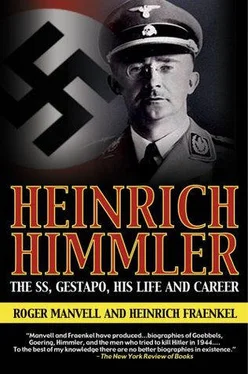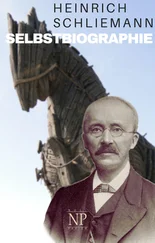12
Himmler did not consider designs for his own Reichsführer S.S. seal until the beginning of 1944, when drawings were submitted to him for both a large and a small seal combining the Reich eagle, the S.S. death’s head, oakleaves and gothic lettering. See above Chapter III, Note 11.
13
The files concerning Lebensborn held at Arolsen, now the centre of the International Red Cross Tracing Service for Lost Persons, show that these homes were a constant source of trouble, gossip and scandal, The women, for example, complained officially that their excess milk was siphoned off and that this might spoil the shape of their breasts and make them less desirable. There was trouble over the chocolate allocations, about the medical care, about the way the women were addressed ( Frau was the rule), about artificial insemination, about gratuities for especially prolific mothers, and endless fuss about illicit relations and racial impurity. (Compare Chapter III, Note 18). Underlying everything was Himmler’s sentimental attachment to blond children. On one occasion he excused a man who had blocked his way on the road because his car was full of beautiful, fair-haired progeny.
14
In order to regularize as far as possible his fatherhood of Hedwig’s children, Himmler in a legal document dated 12 September 1944 acknowledged himself their father and became co-guardian with Hedwig of the boy Helge, then aged two, and the baby girl, Nanette Dorothea. Nanette’s birth certificate, dated 20 July, names Himmler as the father, and adds that he had already appeared before an S.S. judge on 25 June to claim official recognition of his paternity.
15
Schellenberg is exaggerating when he claims that Himmler actually lived with Hedwig. Rather, he set her and her children up in their own establishment and visited them just as he continued to visit his wife and daughter in Gmund. Nor need he have gone short of money with which to maintain these households. It was only his own meticulous honesty in matters of finance that prevented him from using expense-accounts, let alone accumulating ill-gotten wealth like the other Nazi leaders. He lived strictly within his official income.
16
For the text of this speech at Metz, see N.C.A. IV, pp. 553-8.
17
Many of these were used in evidence during the Doctors’ Trial, and are quoted in The Death Doctors, from which our own quotations are derived.
18
See Ribbentrop Memoirs, pp. 81-2.
19
See I.M.T. VI, p. 179.
20
N.C.A. V, p. 341.
21
See I.M.T. IV, pp, 29 and 36. For Wolff, compare Frischauer op. cit. p. 149.
22
See below Chap. V, p. 150, and Chap. VI, p. 184.
23
See The Final Solution, pp. 21-2, 76-9, and the Dutch edition of Kersten’s Memoirs, Klerk en Beul (1947), pp. 197-8.
24
See Manvell and Fraenkel, Göring, p. 244.
25
See Russell, The Trial of Adolf Eichmann, p. 205.
26
I.M.T. III, p. 278.
27
See Hoess’s Memoirs, written in captivity after the war.
28
See Cohen, op. cit., p. 114.
29
For our account of this last phase of Heydrich’s life we have relied mainly on Wighton’s biography and Schellenberg’s Memoirs .
1
These instructions, as far as we know, have not previously been published. They exist as a three-page typescript, marked secret, with marginal corrections in Himmler’s hand, and they are held now at the Federal Archives. The pedantic instructions exactly match Himmler’s style; he details, for example, the exact distance at which the execution squads should stand from the prisoner, and whether or not his eyes should be bandaged or his face turned to the wall.
2
I.M.T. XVII, pp. 19-20.
3
See Reitlinger’s The S.S. , p. 263. Official S.S. statistics showed that between June and November 1942, 136, 700 prisoners had been taken into the camps, and that 70,610 had died, 28,846 had been ‘transferred out’ (i.e., gassed), 9,267 executed, and 4,711 released.
4
See N.C.A. III, pp. 467-9.
5
A vivid description of this repulsive hoard is given by Reitlinger in The Final Solution, p. 453.
6
Files of correspondence and memoranda held in the Instituut in Amsterdam, for example, set down the hard deals which the S.S. were negotiating for the sale of Jewish liberties, the minimum price of which was eventually increased from 50,000 to 100,000 Swiss francs.
7
For the text of this speech, see N.C.A. IV, pp. 558-78.
8
Various terms were used to camouflage genocide. These included Aussiedlung (desettlement), Abbeförderung (removal), and Auflockerung (loosening-up). Such terms were in keeping with the fiction that ghettoes such as that at Theresienstadt had the status of an ‘Alters-Ghetto’, that is, a place of pleasant retirement for elderly Jews, and so called in order to give a favourable impression. Himmler was very angry when he heard that the true nature of the ghetto at Theresienstadt had leaked out.
9
This story has been most eloquently told by John Hersey in his book, The Wall. A full account of the revolt appears in The Final Solution, p. 274 et seq.
10
The bare notes for this speech have, however, been preserved. See I.M.T. documents, PS 910, and The Final Solution, p. 256.
11
I.M.T. document, PS 1061.
12
See The Final Solution , p. 490. For comparison, it may be of interest to note that in a speech fourteen months later, on 25 May 1944, Himmler quoted to an audience of legal men, including the principal judges, the numbers in the concentration camps as 50,000 Germans and 300,000 aliens.
13
The facts for this brief survey of the fate of the Jews in various parts of Europe over which Germany exercised control is derived from The Final Solution .
14
In conversation with R.M. in Stockholm, Frau Irmgard Kersten recalled how she accompanied her husband and Himmler to Italy on this occasion; this was the only time she had any direct dealings with Himmler, whom she always tried to avoid. After lunch one day in Rome, Himmler made a special point of talking to her about the need to be rid of the Jews and the Jehovah Witnesses, and even delayed his departure on an official journey to continue the lecture he gave her. He evidently felt the need to make an ally of Kersten’s German wife of whom he saw so little.
15
Hoess’s Memoirs, p. 148.
16
The Jehovah Witnesses, apart from their pacificism, exacted some response in Himmler’s nature. He openly admired their fanaticism, their sobriety and their desire for hard work. It irritated him profoundly that such good people should refuse to co-operate.
17
Himmler never used his special train as a centre for self-indulgence after the manner of Goring. The surviving record of the food taken aboard on 12 December 1942 is extremely modest: it’s cost amounted to 20 marks, 75 pfennigs.
18
In a recent book which makes a study of Hitler’s medical record, it is only fair to point out that the document seen by Kersten testifying to Hitler’s alleged syphilis is not mentioned. See Dr Johann Rechtenwald, Woran hat Hitler gelitten. Indeed, it now seems certain that Hitler was not suffering from the after-effects of syphilis but, as has often been stated, from Parkinson’s disease ( paralysis agitans ) .
19
Another intimate adviser was, of course, the former S.S. General, Karl Wolff, who acted as Himmler’s liaison officer at Hitler’s headquarters until 1943, when he was appointed Military Governor of Northern Italy. Prior to his recent sentence he was held in custody at Stadelheim prison in Munich, and there H.F. was allowed to interview him on several occasions. He is a man of some charm and humour, and Himmler always addressed him affectionately as Wölfchen.
Читать дальше











